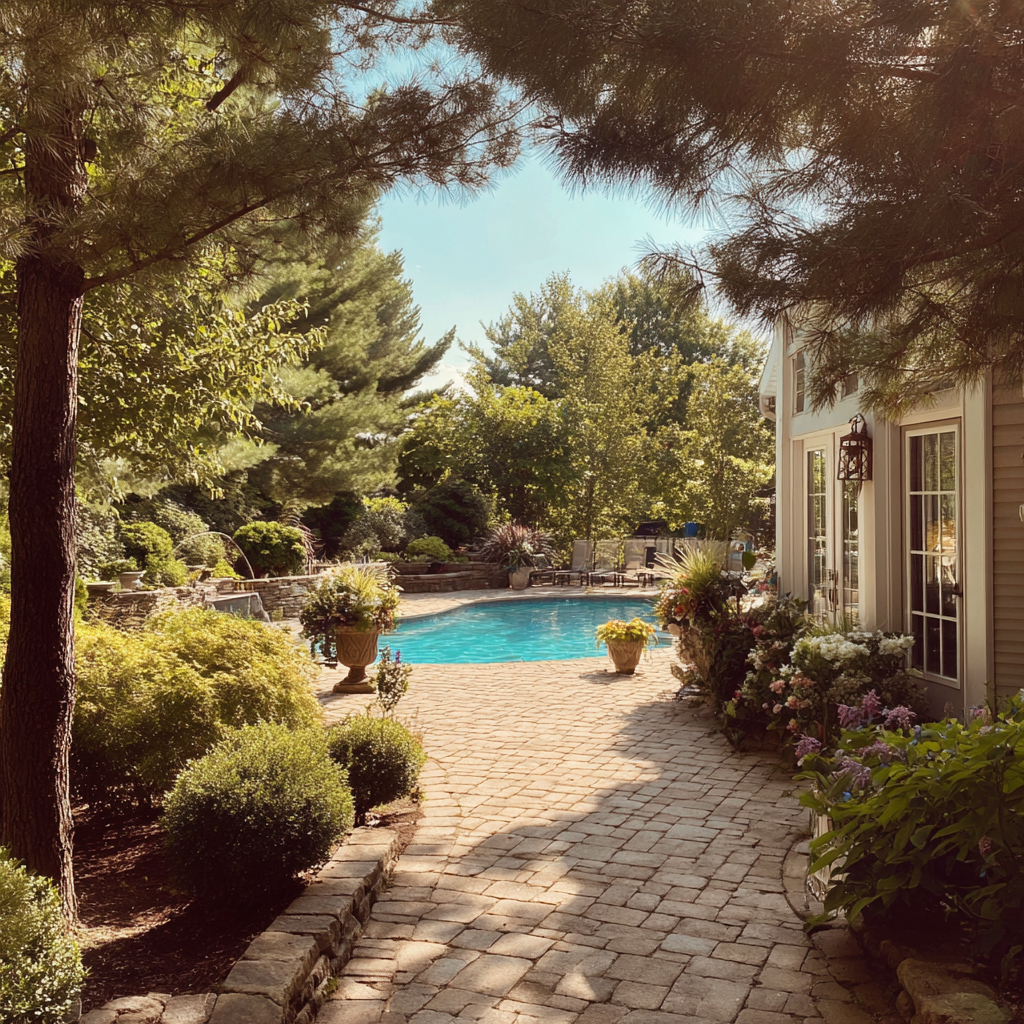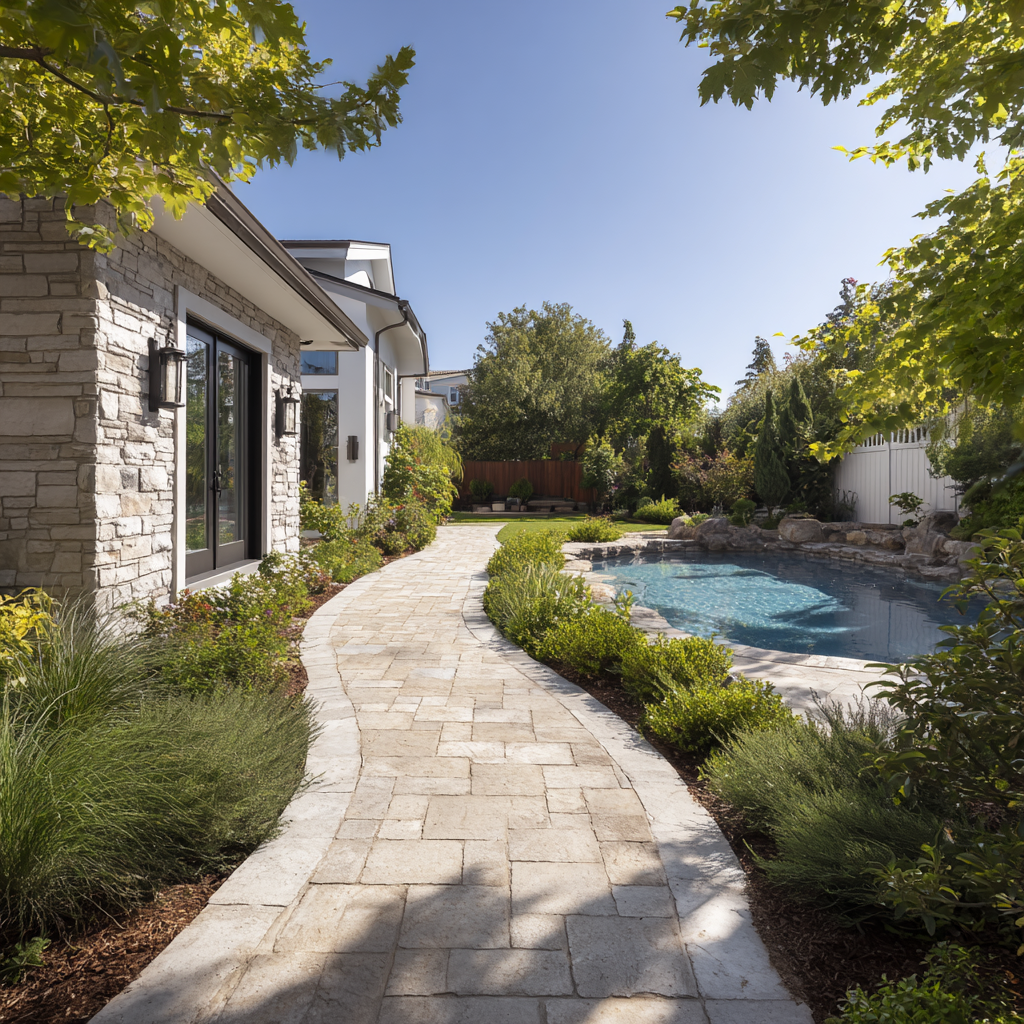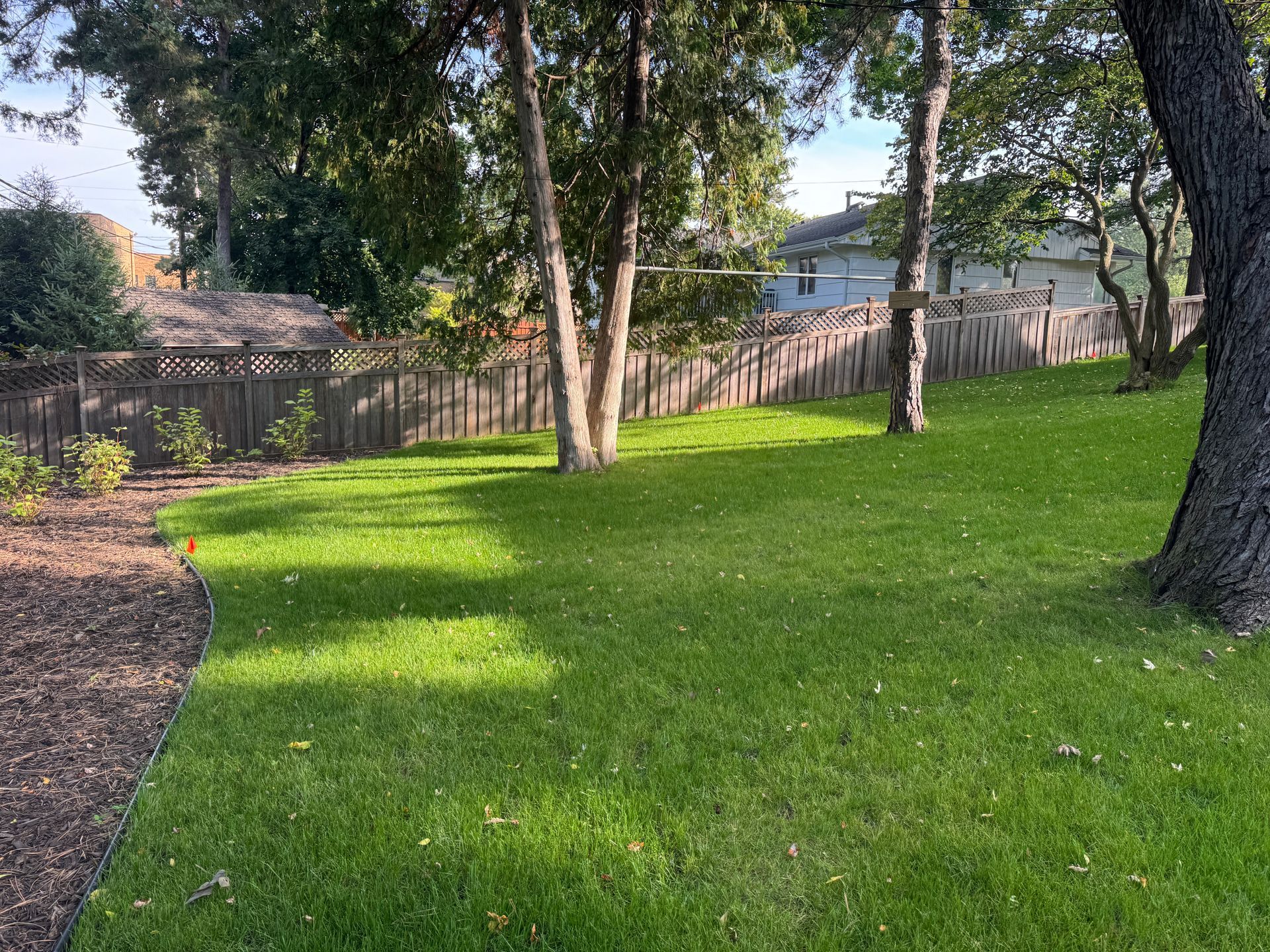Poolside Landscaping in Plymouth: Designs That Last
Making the Most of Your Oasis

Four elements determine whether your pool becomes the centerpiece of an exceptional outdoor living environment or an expensive disappointment: space planning that accommodates real family use, drainage engineering that survives Minnesota's brutal freeze-thaw cycles, material selection that handles both pool chemicals and weather extremes, and installation timing that protects your investment.
Most Plymouth families invest $150,000+ in pools expecting resort-style results, then discover their pool company's "complete package" includes only basic concrete perimeters that provide minimal functional space. The decisions about materials, drainage systems, and space allocation around your pool determine whether you'll be enjoying resort-style outdoor living or dealing with costly repairs and cramped functionality. Whether you're planning a new pool installation or renovating an existing concrete deck that's failing, understanding how professional poolside landscaping works will protect your investment and create the outdoor entertaining environment your Plymouth property deserves.
Space Planning: From Pool Deck to Outdoor Living Environment
Pool companies deliver what they promise—a functional pool with basic concrete perimeter—but families need much more to create the outdoor lifestyle they're envisioning. Standard 4 to 6 foot concrete borders provide zero consideration for how you'll actually use the space around your pool.
Here's what families actually need around pools: dedicated dining areas positioned for easy kitchen access, lounge zones with sight lines for supervising kids, shade structures for all-day comfort, and circulation space that doesn't force people to walk between swimmers and sunbathers. Standard pool decks provide none of this.
I get calls regularly from Plymouth families who spent their first summer climbing over each other, eating meals balanced on pool steps, and struggling to find comfortable spots that weren't blazing sun or completely detached from pool activities. By year two, they're looking at $40,000+ renovations to create the outdoor living spaces they assumed they were getting with their pool investment.
The clay soil common throughout Plymouth compounds this problem. That minimal concrete deck starts showing stress cracks from freeze-thaw cycles, while poor drainage creates standing water that accelerates deterioration. Meanwhile, you're realizing you need professional landscape design to create functional outdoor living areas—work that should have been coordinated with your pool installation.
Professional poolside design starts with understanding how your family will actually use the space, then engineering drainage and selecting materials that survive Minnesota's climate while supporting your outdoor lifestyle goals.
Pro Tip: Even if you're working with a pool contractor who "includes landscaping," verify they're using landscape professionals rather than concrete subcontractors. The skill sets are completely different.
Drainage Engineering: The Foundation of Long-Term Success
Standard pool deck drainage fails spectacularly in Plymouth's clay soil. Pool contractors typically slope concrete away from the pool edge and call it done, but clay doesn't absorb water—it sheds it toward your home's foundation or creates standing water that freezes and destroys your deck.
Professional drainage design for poolside areas requires understanding how water moves through clay soil and engineering systems that protect both your pool infrastructure and surrounding landscape investment. This means channel drains positioned to capture deck runoff, drain tile systems that prevent water from accumulating under hardscaping, and proper grading that directs water to appropriate discharge areas.
The consequences of inadequate drainage go beyond aesthetics. Water infiltration around pool structures can damage liners, cause deck settling, and create freeze-thaw damage that requires expensive structural repairs. I've been called to properties where pool decks have heaved 4-6 inches due to frost action from poor drainage—repairs that typically run $25,000+ and require partially rebuilding the pool deck.
Clay soil also affects the timing of drainage work. Unlike sandy soils that drain quickly, clay requires strategic drainage installation before any hardscaping begins. Trying to retrofit drainage through completed pool decks means jackhammering expensive work and often compromising the effectiveness of the drainage system.
Professional drainage design also considers pool equipment access and utility routing. Proper planning ensures drainage systems don't interfere with pump access, chemical storage areas, or electrical systems while providing long-term protection for your entire pool investment.
Pro Tip: Install drain tile below any hardscaping around pools in clay soil. The upfront cost is minimal compared to replacing settled or frost-damaged decking later.
Material Selection That Survives Minnesota Winters
Concrete pool decks crack in Minnesota—it's not a question of if, but when. The freeze-thaw cycles that hit Plymouth create expansion and contraction that concrete can't accommodate, especially around pools where chemical exposure and constant moisture accelerate deterioration.
Pavers and natural stone perform dramatically better in freeze-thaw conditions because individual units can move slightly without creating visible damage. When properly installed with appropriate base preparation and drainage, paver pool decks typically last 20+ years with minimal maintenance compared to concrete's 8-12 year lifespan in our climate.
Natural stone options like bluestone, limestone, and certain granites provide both durability and slip resistance that's crucial around pools. The key is selecting materials that handle pool chemicals without staining or degrading. Softer stones like sandstone often discolor from chlorine exposure, while properly sealed natural stone maintains its appearance with basic maintenance.
The initial investment difference between concrete and quality stone materials typically runs $8-15 per square foot, but the long-term value equation favors stone significantly. When you factor in concrete replacement costs every 8-10 years plus the disruption to your outdoor living spaces, quality materials pay for themselves through longevity and reduced maintenance.
Material selection also affects comfort and safety. Textured surfaces that provide grip when wet while remaining comfortable for barefoot use require understanding how different materials perform in pool environments. This knowledge separates contractors who understand outdoor living from those focused solely on basic installation.
Pro Tip: Test material samples around your existing pool or visit installations to experience how different surfaces feel when wet. Appearance matters, but comfort and safety determine how much you'll actually use your pool area.
Creating Functional Outdoor Living Zones
The pool deck space planning that transforms basic swimming into resort-style outdoor living requires understanding traffic patterns, sight lines, and activity zones. Most pool installations ignore these considerations, leaving families to figure out furniture placement and flow after the concrete is poured.
Dining areas need positioning that allows easy access from your kitchen without crossing pool activities. This typically means locating outdoor dining spaces between your home and pool rather than on the far side, with adequate space for chairs to pull out and people to move around tables without crowding swimmers.
Lounge areas require different considerations—sight lines for supervising children, proximity to shade structures, and enough space that people can move between chairs without stepping around sunbathers. The most successful poolside designs create distinct zones for different activities while maintaining visual connection across the entire space.
Shade integration becomes critical for all-day pool use. Pergolas, umbrellas, or architectural shade structures need positioning that provides relief during peak sun hours without casting shadows on the pool during prime swimming times. This requires understanding sun patterns throughout your pool season and planning structures accordingly.
Traffic flow planning prevents the crowded feeling that ruins pool experiences. Professional design ensures pathways that allow movement between house, pool, and activity areas without forcing people to navigate around furniture or interrupt ongoing activities.
Pro Tip: Plan for furniture storage and seasonal changes during the design phase. Fixed elements like fire features and built-in seating should enhance rather than limit your flexibility for different entertaining scenarios.

Professional Installation Timing and Coordination
The sequencing of pool and landscape installation affects both quality and cost. Most pool contractors push for simultaneous installation to minimize disruption, but this approach often compromises landscape results and creates expensive coordination problems.
Professional landscape installation works best after pool completion when we can see actual grade conditions, equipment placement, and drainage patterns. Pool installation inevitably changes site conditions, and landscape contractors need to respond to these realities rather than assumptions made during initial planning.
Equipment access becomes critical for quality landscape installation around pools. Professional hardscape installation requires machinery for excavation, material delivery, and compaction that can damage completed pool decks if access isn't properly planned. Staging areas for materials and equipment need consideration during both pool and landscape planning phases.
Protecting pool systems during landscape work requires coordination between contractors and understanding of how landscape installation affects pool equipment, plumbing, and electrical systems. Amateur coordination often results in damaged pool infrastructure or compromised landscape installation.
Seasonal timing in Minnesota affects both pool and landscape work. Pool installation typically happens spring through early fall, while landscape work often extends later into fall. Understanding how weather affects both installations helps ensure quality results for both phases of your project.
Pro Tip: Even if you're using the same company for pool and landscape work, insist on separate phases with pool completion before landscape installation begins. This ensures each contractor can focus on quality rather than working around ongoing work from other trades.
Long-Term Value and Maintenance Strategy
Quality poolside landscaping typically recovers 70-85% of its cost in property value while dramatically improving outdoor lifestyle. In Plymouth's competitive market, properties with well-designed pool environments consistently outperform those with basic concrete decks.
Material longevity affects long-term value significantly. While concrete pool decks require replacement every 8-12 years, quality stone installations last 20+ years with basic maintenance. This longevity becomes particularly valuable when you consider the disruption and cost of renovating around existing pools.
Maintenance requirements vary dramatically between material choices. Concrete requires regular sealing, crack repair, and eventual replacement. Natural stone and pavers need occasional cleaning and re-sanding but rarely require structural repairs. Understanding these differences helps you make informed decisions about initial investment versus long-term ownership costs.
Seasonal care in Minnesota includes winterization considerations for pool equipment and landscape elements. Professional installation anticipates these requirements and designs systems that simplify seasonal maintenance rather than complicating it.
Planning for future changes becomes important as families' needs evolve. Professional poolside design accommodates modifications like adding outdoor kitchens, fire features, or shade structures without requiring complete reconstruction.
Pro Tip: Budget for quality installation initially rather than planning to upgrade later. Retrofitting around completed pools typically costs 40-60% more than doing comprehensive work during initial installation.

Professional Considerations for Plymouth Pool Properties
How do Plymouth's soil conditions affect poolside landscaping options?
Clay soil throughout Plymouth requires specific drainage engineering and base preparation that many contractors don't understand. Professional installation includes drain tile systems and proper base materials that prevent the settling and frost damage common with amateur installations.
What's the typical timeline for poolside landscape installation?
Professional poolside landscaping typically requires 2-3 weeks after pool completion, depending on scope and weather. The key is waiting for pool installation to settle and final grading to be established before beginning landscape work.
How does poolside landscaping affect property values in Plymouth?
Quality poolside environments typically add $40,000-80,000 to property values in Plymouth's market, depending on scope and integration with overall landscape design. The key is professional installation that enhances rather than conflicts with your property's character.
Can existing concrete pool decks be upgraded with professional landscaping?
While possible, working around existing concrete limits design options and often requires more expensive installation methods. The most cost-effective approach typically involves removing failed concrete and installing comprehensive hardscape solutions.
What maintenance should Plymouth homeowners expect for different poolside materials?
Concrete requires sealing every 2-3 years and crack repairs throughout its lifespan. Natural stone and pavers need annual cleaning and occasional re-sanding but rarely require structural maintenance. Professional installation significantly reduces maintenance requirements for all materials.
Planning a pool project that deserves professional landscape integration? We design poolside environments that enhance your outdoor lifestyle and protect your investment through Minnesota's challenging climate.










